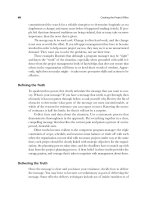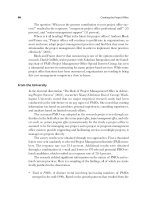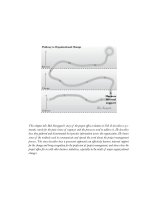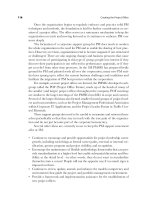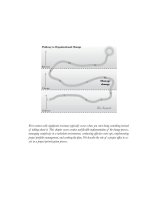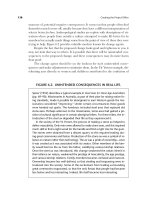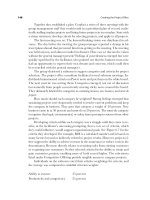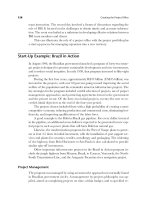Tài liệu Creating the project office 28 doc
Bạn đang xem bản rút gọn của tài liệu. Xem và tải ngay bản đầy đủ của tài liệu tại đây (149.54 KB, 10 trang )
This chapter completes the process of transforming the organization to enterprise project man-
agement. It answers the question of how to make the change stick and embed enterprise project
management into the culture so that the principles become habits for everyone. Dennis Cohen pre-
sents a sample intervention program and framework that suggest a combination of action areas
on which to focus: Leadership, Learning, Means, and Motivation. These areas are then applied
to the important success factors necessary to support enterprise project management.
1.
3.
4.
5.
6.
7.
8.
9.
10.
Looking forward
11.
Refreeze
Change
Unfreeze
2.
Pathway to Organizational Change
249
CHAPTER TEN
LOOKING FORWARD:
EMBEDDING PROJECT PRACTICES
IN THE CULTURE OF THE ORGANIZATION
Dennis Cohen, Strategic Management Group
O
nce the project office begins to fully implement fundamental changes in the
organization to support successful projects, a new problem emerges that is
often ignored. The problem is how to consolidate the changes and prevent the
company from sliding back to business as usual—the former steady state. Anyone
who has been involved in large-scale organization change is always amazed at the
resiliency of the old ways of doing things. Given the slightest misstep or the mo-
mentary drop in vigilance, what once seemed to be a successful change quickly
slips back to the way things were.
In this chapter we focus on a number of methods to prevent this from hap-
pening. They are based on transforming the fundamental nature of the PMO—
from center of excellence into cultural change agent. As a center of excellence
the PMO is primarily the facilitator of a set of tools and techniques to run
projects, programs, and project portfolios and the sponsor of a set of com-
petencies for project managers to effectively use the tools and techniques. As
a cultural change agent, the PMO becomes the sponsor of project management
as a core business process. This requires increasing the breadth and depth
of project management so that project practices reach all members of the or-
ganization. This process helps embed project practices into the culture of the
organization.
Y
Depth and Breadth
As seen in earlier chapters, when project management is first introduced into an
organization, it often starts off as training for project managers. When projects
are not going well, the first assumption is that project managers simply do not
know how to do their job. If we just train them in a body of knowledge, the prob-
lem will be solved. This, of course, usually turns out to be a false promise. Edu-
cation alone is never enough. Changing the organization so that projects become
more successful is complex and time-consuming. And even implementing the tools
and techniques, process, competencies, and best practices is not enough. Until the
basic assumptions of project management become embedded in the underlying
assumptions of the organization’s culture, there will always be a tendency for the
equilibrium of the system to swing back toward the original status quo.
Most PMOs focus on the typical PM community in areas that traditionally
do projects—R&D projects for new product development, client engagement
projects in a professional services firm, or internal projects by IT departments.
Because these are high-profile projects involving core aspects of the business and
large budgets, they are almost always the first targets of a PMO. The focus is on
the professional project managers and team members. When things are done right
the introduction includes managers of team members and upper managers who
sponsor projects and serve on project review boards. People in these roles are
taught the basic tool kit and best practices in PM and supported in using it.
In one financial services firm, major projects received all the attention. A
PMO brought in consultants and training companies to help develop policy,
process, and procedures as well as to train everyone involved in large strategic
projects. They ignored the plethora of projects taking place throughout the or-
ganization in other areas because each one was much smaller than any of the
250 Creating the Project Office
Establish sense of
urgency— clear danger
• increase breadth and depth of PM
• focus on framework: leadership,
learning, means, motivation
• apply critical success factors (9)
Leading
Organizational
Change
to PBO
Create guiding coalition—
powerful forces
Develop vision and
strategy—focus
Manage the change—
short-term wins, broad-based
action, consolidate gains
Develop broad-based action—
keep moving, implementing
Staff and operate—
In or out?
Make change stick—
new PBO culture
The tale we tell
Communicate the change
vision—tell the tale
strategic projects. However, in total this tier of work probably had as much if not
more impact on the business of the company.
The PMO did not even officially acknowledge that these projects existed.
During interviews with people who were struggling to implement projects outside
the purview of the PMO, it became obvious that the most elementary project
management best practices were being ignored. People confided that they went
to kickoff meetings assuming that they were playing the role of project manager
and finding that everyone else at the meeting had the same idea. In essence there
were no project managers because the whole team was the project manager. The
accidental project managers, team members, and project sponsors were simply
going about their business as usual untouched by the PMO and all its efforts in
the IT area. Since many of these smaller projects were essential for supporting
the larger strategic projects, the business improvement potential of the larger
strategic projects was squandered because PM as a core business process was not
spread throughout the organization.
Solving this breadth problem requires that PMOs established at division or
departmental levels are multiplied across the organization. One approach is to es-
tablish a corporate PMO to support the spread, as suggested in Chapter Four.
Eventually, as the concept of the corporate office becomes more business process
oriented, individual project offices should lose their ties to structural boundaries
in the organization. They should be associated with related business processes to
promote venture project management (Cohen and Graham, 2001), which was
discussed in Chapter Two. This approach links project triple constraints to longer-
term business outcomes and helps to embed project management into core busi-
ness processes. For instance, instead of a project office focused only on R&D, the
new perspective would include product management from concept generation
through development to manufacturing and on through to sales. This way the or-
ganization begins to rely on project management as the primary driver of the cash
flow associated with the whole value chain.
Changing the Project System
For projects to proceed more successfully, something like the Project Management
Body of Knowledge (PMBOK
™
) and its associated best practices must be carried out,
but individuals cannot carry them out alone. An individual certified project man-
ager is not enough to make a successful project. It takes an organization. The
project manager is only part of the equation. The project team, the system of
project stakeholders who influence the project, and the rest of the organization
Looking Forward 251
who constitute the project’s environment must support the project manager for
projects to be successful. The first step is not to educate just the PM but rather to
educate and change the behavior of all actors in the environment. By doing this
the organization can begin to change the set of reciprocal roles and relationships
that constitute the project management system.
One example is the issue of project planning. In general an important con-
tributor to project success is that sufficient time was devoted to planning by the
project manager and the project team. The time needed to plan and when it will
be needed will vary from project type to project type. Projects that do not devote
the proper amount of time to the planning process suffer from problems that lead
to rework. This extends the time of the project beyond what was saved by not
planning enough in the first place. The solution to this problem looks simple.
Teach project managers how to plan and make sure they understand that it is im-
portant to plan. This is often not enough, however. Upper managers, impatient
to move up the project deadline, often demand that the team stop meeting so
much (to plan) and get to work. Team members often resist the planning because
they do not appreciate its importance, or their bosses do not support their wast-
ing all that time in meetings when there is departmental work to be done. Not
until all relevant actors learn their reciprocal roles in the planning process and
play them well will planning proceed as needed to produce successful projects.
This means that project management is not just for project managers anymore.
It is for everyone as it becomes recognized as a core business process.
The importance of the project environment was demonstrated by Graham
and Englund (1997). As mentioned in Chapters Two and Three, the Strategic
Management Group (SMG), a performance-consulting firm based in Philadel-
phia, worked with Graham to develop the Project Environment Assessment Tool
(PEAT)—a tool designed to diagnose the areas of strength and weakness in the
system (see discussion of success factors later in this chapter).
SMG and Graham also developed an organizationally based performance
consulting approach to providing solutions for poor project system performance
as diagnosed by PEAT. At the core of this performance consulting approach is an
online training and performance support program aimed at all important recip-
rocal roles and relationships in the project management system. This program,
called Maximizing Project Performance (MPP), targets the system as a whole in
order to align and mobilize its actors to provide a foundation of shared knowl-
edge, assumptions, and reciprocal role-based best practices to anchor improve-
ment. Because it is Internet based, the program can influence large numbers of
people quickly. This, along with other supporting tactics, helps to accelerate and
then deepen the change. The way this works is based on both the dynamics of in-
dividual learning in support of behavior change and the way that these dynam-
252 Creating the Project Office
